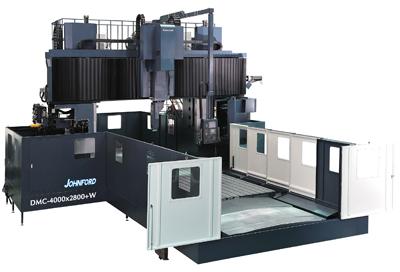
Available from Absolute Machine Tools, Johnford DMC Series double-column moving table bridge mill is created from a one-piece Meehanite cast iron bridge/column assembly that reportedly takes up 30 percent less floor space than comparable C-frame vertical machining centers. Available in both moving table and sliding column (fixed-table) versions, ranging from 36- x 36- x 30-inches of travel up to 60-ft. x 20-ft., the bridge mills have a long base casting with complete support of the table over the full 51 inches of Y-axis travel, allowing massive loads to be machined.
The Y and Z axes hold fixed loads at all times while the X-axis carries the only dynamic load allowing for tight machining and tight tolerances during high-speed machining operations. Because there is no table overhang, X-axis pitch and yaw are eliminated. The spindle centerline-to-column distance is minimized offering further rigidity. The machine's heavily ribbed cast iron construction provides long tool life and part surface finish. The combination of twin screw-type conveyors and a caterpillar conveyor ensures complete chip removal with little manual cleaning. Additionally, finite element analysis (FEA) is used to design each bridge mill, simulating the effects of real world conditions, including vibration, heat, fluid flow and other physical impacts.
The DMC-900-1500H small-frame series bridge mills feature a fixed column with moving table, X-axis travel from 35.40-in. to 59.1-in., Y-axis travel of 35.4-in. and a Z-axis travel of 30-in., and table load capacities from 6600- to 13,200-lbs.
The DMC-1600-3100H medium-frame series offers a fixed-column construction with moving table, X-axis travel from 63-in. to 161.4-in., Y-axis travel of 51.2-in., and Z-axis travel of 31.5-in. with a table load capacity of 13,200 lbs.
There are several DMC versions that offer multi-axis and five-face solutions. The 2100S-6100 SH S Series offer a fixed-column moving table with X-axis travels from 82.7-in. to 240.2-in., Y-axis travel of 70-in. and Z-axis travel of 31.5-in. while the 3100P-6100PH P Series feature the same fixed-column moving table with longer travels: X-axis ranges from 122-in. to 240.1in. Y-axis is 90.5-in. and Z-axis is 31.5-in. Table load capacities range from 22,000lbs. to 26,400 lbs. and 22,000 lbs. to 35,20 lbs., respectively.
The large DMC-4000x2800x800 – DMC-4000x2800+5-Face W-Axis Large Multi-Axis Series can handle 44,000-lbs. of table load with an X-axis travel of 118-in. through 236-in., Y-axis travel of 110.2-in. to 189-in., Z-axis travel of 31.5-in. to 42-in., and a W-axis travel of 39.4-in. to 78.7-in. on a fixed-column moving table.
Finally, the SDMC Series custom-made unlimited size sliding double-column series multi-axis, five-face series features moving-column and fixed-table gantry mills with X-axis travels ranging from 157-in. to 720-in., Y-axis travels of 72-in. to 236-in., Z-axis travels from 31.5-in. to 42-in., and W-axis travels from 39.4-in. to 78.7-in. Table load capacity is 614-lb./ft.2.
Contact Details
Related Glossary Terms
- centers
centers
Cone-shaped pins that support a workpiece by one or two ends during machining. The centers fit into holes drilled in the workpiece ends. Centers that turn with the workpiece are called “live” centers; those that do not are called “dead” centers.
- milling machine ( mill)
milling machine ( mill)
Runs endmills and arbor-mounted milling cutters. Features include a head with a spindle that drives the cutters; a column, knee and table that provide motion in the three Cartesian axes; and a base that supports the components and houses the cutting-fluid pump and reservoir. The work is mounted on the table and fed into the rotating cutter or endmill to accomplish the milling steps; vertical milling machines also feed endmills into the work by means of a spindle-mounted quill. Models range from small manual machines to big bed-type and duplex mills. All take one of three basic forms: vertical, horizontal or convertible horizontal/vertical. Vertical machines may be knee-type (the table is mounted on a knee that can be elevated) or bed-type (the table is securely supported and only moves horizontally). In general, horizontal machines are bigger and more powerful, while vertical machines are lighter but more versatile and easier to set up and operate.
- pitch
pitch
1. On a saw blade, the number of teeth per inch. 2. In threading, the number of threads per inch.

